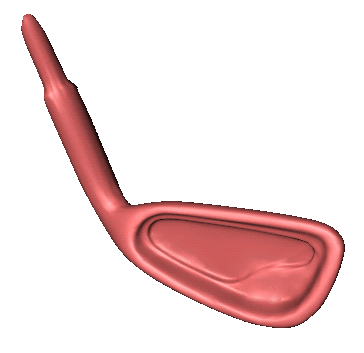![[UW shield]](http://www.uwaterloo.ca/images/UWlogo.GIF)
CS 679 - Subdivision Surfaces , 1999
Vincent Ma

The goal of this project is to give a visual comparison between different
subdivision schemes. Given a certain control mesh to start with, I wanted to
show the kind of surface each scheme produces.
There are 3 schemes implemented in this project:
- Simplest Subdivision Scheme (or Peters as I'd like to call it) which
simply takes the midpoints of each edge and connects to other midpoints of
those edges that are adjacent and share a face. Then, new faces are
created, one for each old face, and one for each old vertex. This scheme
generalizes the "4-direction box-spline".
- Catmull-Clark
With this scheme, new vertices are calculated for each face, edge and
vertex of the original mesh, then, for each vertex, a new face is created
that spans the new vertex, "midpoints" of pairs of old edges, and the face
vertex. This scheme generalizes bicubic B-spline surfaces.
- Doo-Saban
For each vertex-face pair, a new vertex is created. Then, connecting these
in an appropriate way will create a new face for each old face, edge, and
vertex. This scheme generalizes biquadratic B-spline surfaces.
To implement these I first implemented a Half-Edge data structure that will
store the polygonal data. The half-edge structure will allow me quick access
between adjacent vertices/edges/faces and it theoretically will speed things up.
On top of this data structure I added functions to evaluate the face, edge and
vertex points that I needed for evaluating each different subdivision scheme.
Finally, I added a GUI that allows a user to interactively view a control mesh
and the resulting subdivision surface.
In addition, I've implemented "infinitely sharp edges" for the Catmull-Clark
subdivision scheme. Essentially, it means that for edges that are labelled
"sharp" different rules will be used to calculate the edge/vertex points used
in the subdivision calculation.
In the GUI, the user can select one or more edge. Selected edges are tagged
as sharp. By selecting different sets of edges, the user can create
differently shaped surfaces from a single common control mesh.
The user can save the result surface out to Inventor format files viewable
in "ivview".
References
- T. DeRose, M Kass, T Truong, SUBDIVISION SURFACES IN CHARACTER ANIMATION
Computer Graphics. Pages 82-94, 1998
- E. Catmull, J. Clark. RECURSIVELY GENERATED B-SPLINE SURFACES ON ARBITRARY
TOPOLOGICAL MESHES. Computer Aided Design, 10(6):350-355, 1978
- G. CHAIKIN. AN ALGORITHM FOR HIGH SPEED CURVE GENERATION. Computer Graphics
and Image Processing, 3:346-349, 1974
- M. Halstead, M Kass, T DeRose, EFFICIENT FAIR INTERPOLATION USING CATMULL-CLARK
SURFACES. Computer Graphics 27(3):35-44, Aug 1993
- H. Hoppe et al, PIECEWISE SMOOTH SURFACE RECONSTRUCTION. Computer Graphics,
28(3):295-302, July 1994
- J Peters, U Reif, THE SIMPLEST SUBDIVISION SCHEME FOR SMOOTHING POLYHEDRA.
March 4th, 1997
- A. Holden, SHAPES, SPACE, AND SYMMETRY. Columbia University Press, 1971
- K. Joy, ON-LINE GEOMETRIC MODELING NOTES,
http://graphics.cs.ucdavis.edu/CAGDNotes/
November 7, 1996
![[UW shield]](http://www.uwaterloo.ca/images/UWlogo.GIF)
